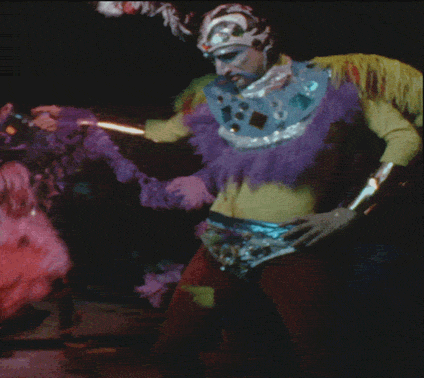
‘In his filmmaking, Smith sought to create an aesthetic of delirium. Through his use of outdated film stock and baroque subject matter, he pushed the limits of cinema, liberating it from the formality of “good” technique and “proper” behavior. In his best-known film, Flaming Creatures (1963), characters cavort in a setting reminiscent of the court of Ali Baba. The film is a fantasy composed of Androgynes and Transvestites, who are ambiguously equated as to disarm any distinction between male and female. In Flaming Creatures, Smith manages to combine the ornate imagination of his youth with the realities of adult fantasy. The sensual polyamory of the film was used by authorities for their repressive policing of what the government considered to be pornographic at the time. Copies of Flaming Creatures were confiscated at the premiere and it was subsequently banned. Despite not being viewable, the movie gained notoriety when footage was screened during Congressional hearings, and the right-wing politician Strom Thurmond cited it frequently in his anti-porn speeches. The controversy affected Smith deeply and all his later films were purposefully composed as incomplete, open, and “live” in order to subvert the control of authority, in all its forms.
‘Smith’s second feature length film, Normal Love (1963-65) is something of a sequel. Unlike the black and white Flaming Creatures, it is shot in rich color, at outdoor locations including the swamplands of Northern New Jersey and suggests the archetypal gardens of the human imagination. The characters include a variety of 1930s horror film monsters, a mermaid, a lecher, and various “curies” performed by a cast which included Mario Montez, Tiny Tim, Eliot Cukor, Tony Conrad, Diane di Prima, Beverly Grant, and John Vaccaro. In the last scene, one can spot Andy Warhol in the corner of the frame photographing the action as several sublime characters dance on an enormous multi-tiered Claes Oldenburg cake sculpture. In this exemplary scene, one can sense an underground geneology and early community of the New York art scene: from a masterful Jack Smith, to the studious Warhol, and the transforming Oldenburg. The next “feature” film created was No President (1968), originally titled The Kidnapping of Wendell Willkie by the Love Bandit, in reaction to the 1968 Presidential campaign. It mixes black-and-white footage of Smith’s creatures, with old campaign footage of Wendell Willkie, the 1940 Republican Presidential candidate. In addition to No President, Smith produced numerous short films and fragments of short films.
‘Born in Ohio and arriving in New York in 1953, Smith transformed the detritus of post-war downtown New York into a tableaux vivant of exotic glamour and polysexual fantasy. In 1957 he opened the Hyperbole Photography Studio in which he photographed customers/models in compositions that were equal parts Rococo and Hollywood. Working on a shoe-string budget, Smith created an orgy of fantasy that transcended the all-too-pat bounds of camp and revolutionized American film. Upon seeing Flaming Creatures, Jonas Mekas dubbed it the “most luxurious outpouring of imagination, of imagery, of poetry, of movie artistry.”
‘A key figure in the cultural history of Downtown New York film, performance, and art, Jack Smith began producing work in the late 1950s and became one of the most accomplished and influential artists throughout the 1960s, 70s, and 80s. Smith’s method of weaving his life as a performance varied across media and glorified his exploits and adventures through the urban landscape wherein he developed an exuberant and visually stunning vision of the world from the glittering debris of the city, transforming downtown New York into a stage for his forays into photography and film. After a period of about eight years (1961-1969) in which Smith showed the films in their completed forms in conventional film screening settings, he began to incorporate the films and his slides into live performances that he himself named “Live Film.” He created startling stage effects through the spontaneous rearrangement and interplay of recorded imagery on film and slides, along with live action on a “stage,” editing and re-editing the film images in the midst of the performance. This spontaneous editing, however, required a unique form of splicing in which he assembled strands of camera original as well as printed material with masking tape. Thus, Smith managed to create a unique version of the films for each performance. Unlike his contemporaries in the underground film scene, Smith looked to Hollywood for his aesthetic models. In his writings he extolled the early Technicolor achievements of B-actress Maria Montez. Smith’s insubordinate aesthetics within the art scene were mirrored in his progressive politics: Smith formulated theories of popular socialistic thinking that he sought to enact in his work and life. Communal to the point of a celebratory chaos, the idea of the involuntary gesture, usually caused by a technical breakdown in his filmmaking, was melded to his theory of Art-as-Trash to create some of the most visually striking filmic episodes in American cinema.
‘Although in Jack Smith’s lifetime he was much less celebrated than the many people he inspired, Smith’s multi-media influence is evident in the works of a broad segment of contemporary American art. In film, his influence is apparent in the work of his contemporaries, from Andy Warhol, Ken Jacobs, Kenneth Anger, Derek Jarman, and the Kuchar brothers, to contemporary artists such as Guy Maddin, Ryan Trecartin, and John Waters. Smith collaborated with a range of visual artists, frequently with Claus Oldenburg and Carolee Schneemann who created props for Smith’s films sets, which in turn inspired those artists toward new aesthetic trajectories within their own work. In avant-garde theater and performance art, Smith’s influence reaches Robert Wilson, Charles Ludlam, John Vaccaro, Cindy Sherman, John Bock and Richard Foreman.
‘As an innovative and unprecedented artist who rejected so much of his era, from the conservative political climate of an America at war with Vietnam, to the trends of Abstract Expressionism in New York art, to the repression of queer expression and the abstention of the pornographic in high art, Jack Smith, nonetheless, was absolutely and indulgently inclusive. In his art as in his life, Smith transfused styles, mediums, materials, and particularly bodies, in a transcendently new way that defined and still defines counter-culture. As a revolutionary thinker and artist, his revolutions are as culturally pertinent and aesthetically impressive today as they were in his lifetime. The films of Jack Smith provide a rare and magical view into the history, and perhaps even the future, of the American avant-garde.’ — Light Cone
___
Stills
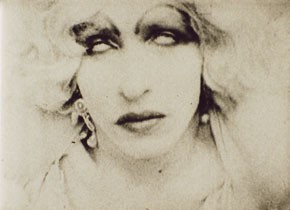

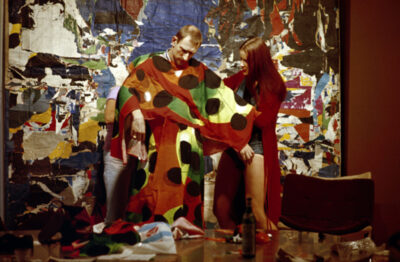

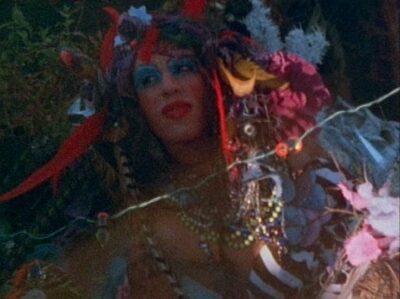
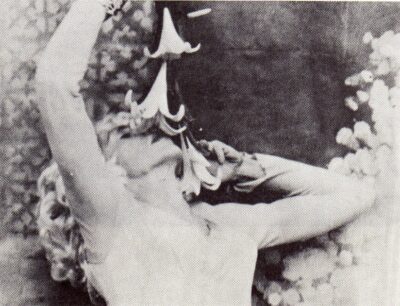
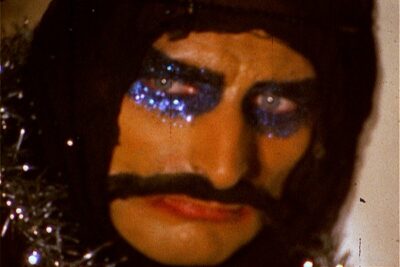
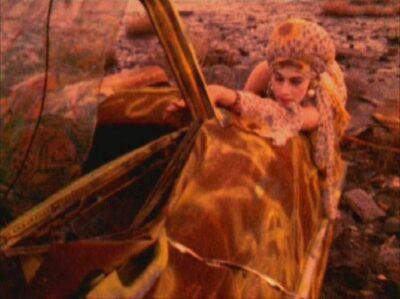
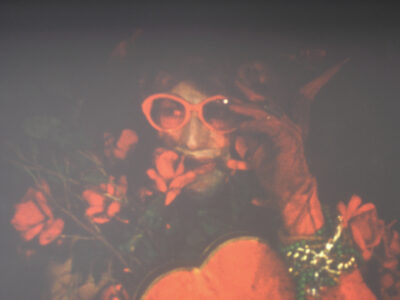
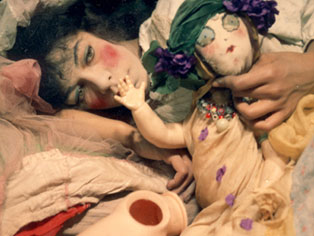

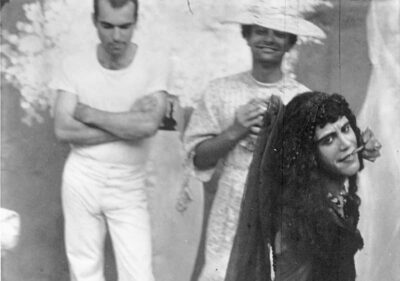
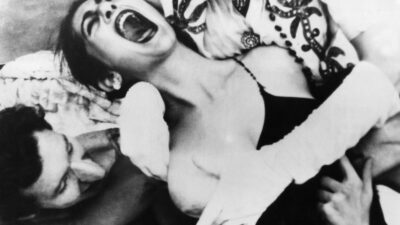
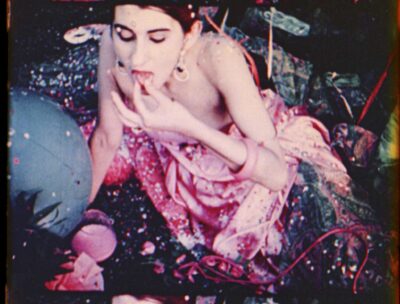

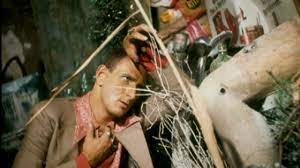



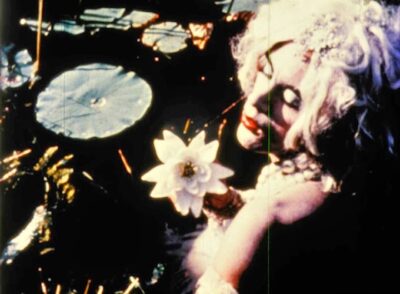
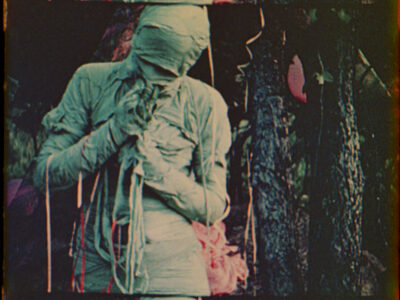



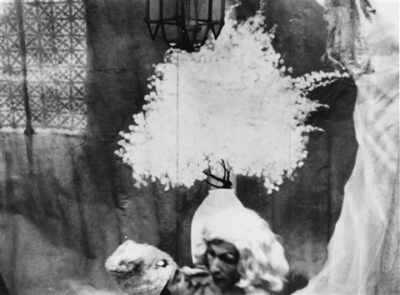
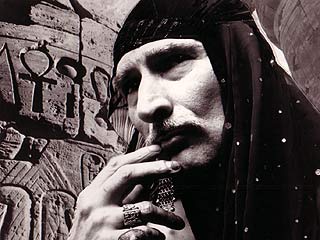
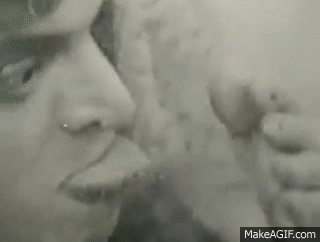
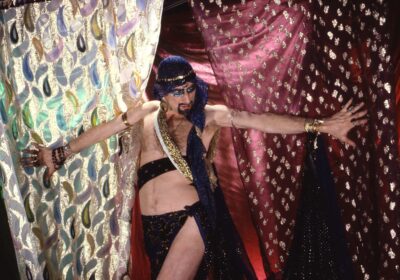
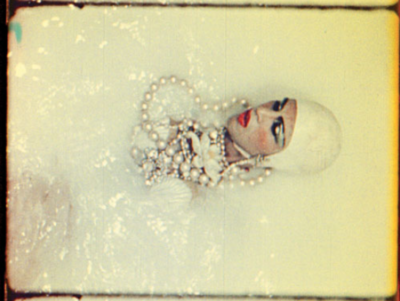
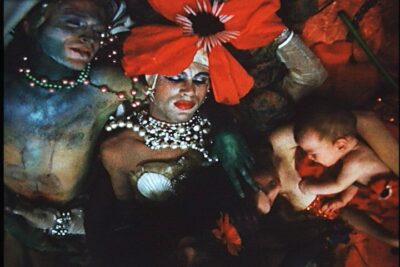
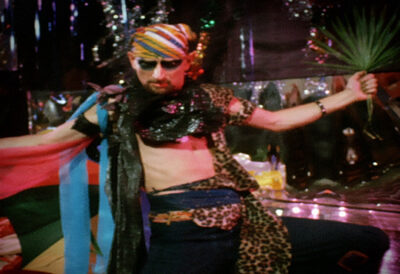
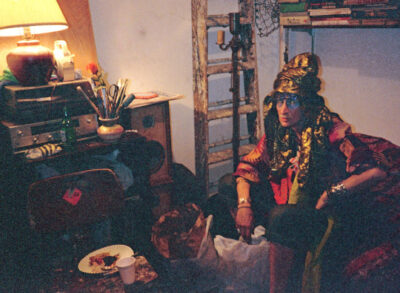
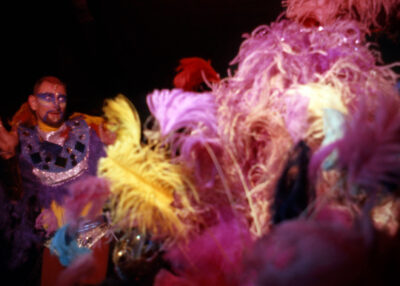
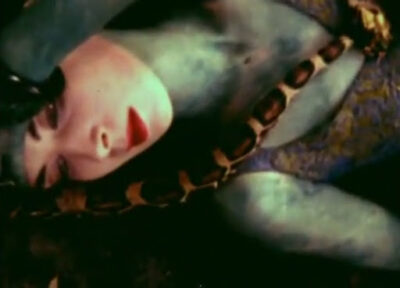

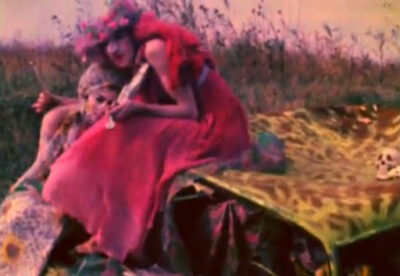
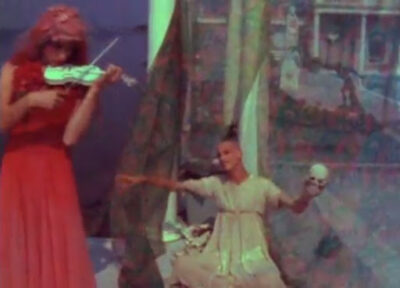
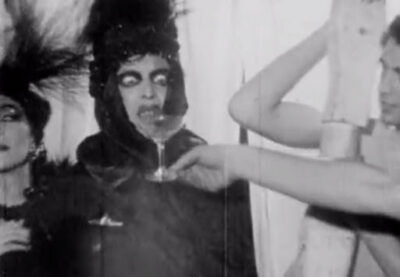
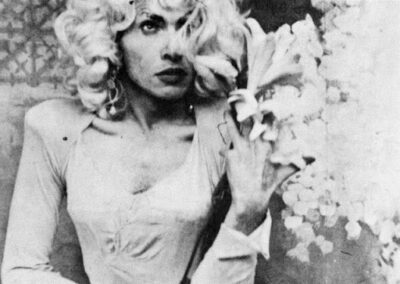
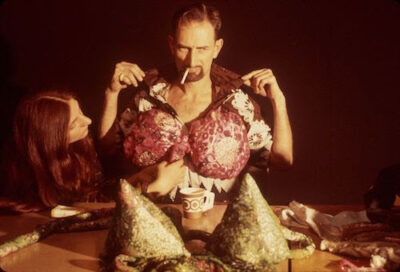


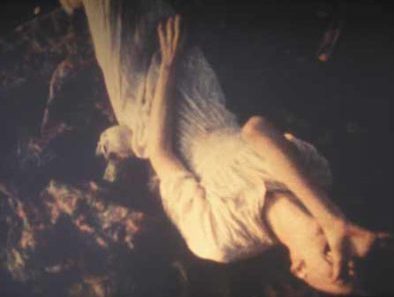
____
Further
Jack Smith @ Wikipedia
Jack Smith @ Light Cone
Jack Smith @ IMDb
Jack Smith @ warholstars.org
Jack Smith Is an Ordinary Name
LIVE FILM! JACK SMITH! Five Flaming Days in a Rented World
YOU DON’T KNOW JACK
TRANSFORMATIONS ON THE MARGIN: JACK SMITH’S VITAL AND DIFFICULT ART
J. Hoberman on Jack Smith’s posthumous career
What’s Underground?: The Films of Jack Smith
The perfect queer appositeness of Jack Smith
The Avant-garde Filmmaker Who Got US Senators All Hot and Bothered
What’s Underground About Marshmallows
FLAMING CREATURES: ICON OF PERVERSION
The Lost Paradise of Jack Smith
Jack Smith and His Secret Flix
Rethinking the edgy filmmaker who made Warhol look tame
JACK SMITH: Art Crust of Spiritual Oasis
The absurdity of fixation: Jack Smith and Flaming Creatures
AESTHETIC DELIRIUM IN JACK SMITH’S ‘FLAMING CREATURES’
The Ever-Unfolding Pasty Triumph: Jack Smith’s Performative Cinema
Sweet Outrage [SCOTCH TAPE & FLAMING CREATURES]
‘Moldy Art’: The Exotic World of Jack Smith
Raging and Flaming: Jack Smith in Retrospect
____
Extras
The Horrors Of Agony (1963)
Trailer: ‘Jack Smith and the Destruction of Atlantis’
Jack Smith, ‘LoveBirds of Paradise’ from the movie ‘Love Thing’
Jonas Mekas on ‘Flaming Creatures’
_______
Ephemera

Business card
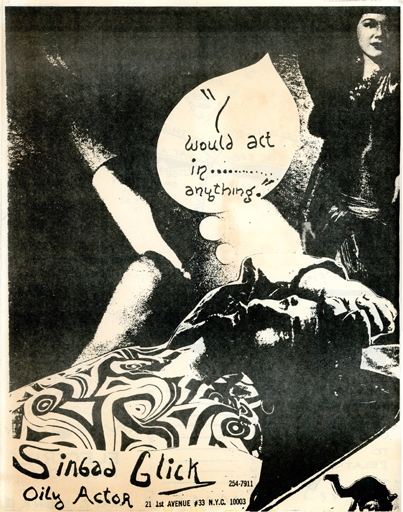
Handout

Handout

Poster
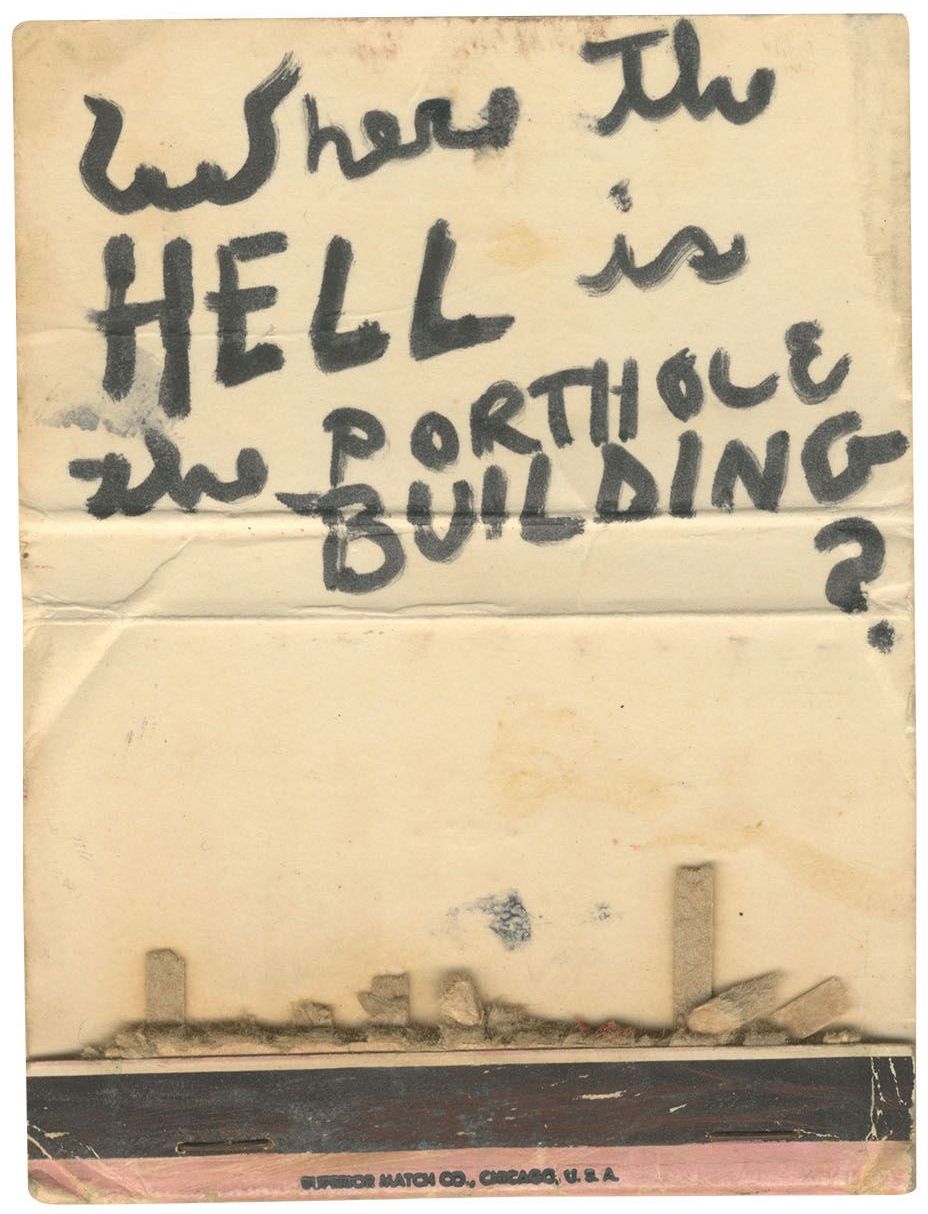
Drawing

Drawing

Poster
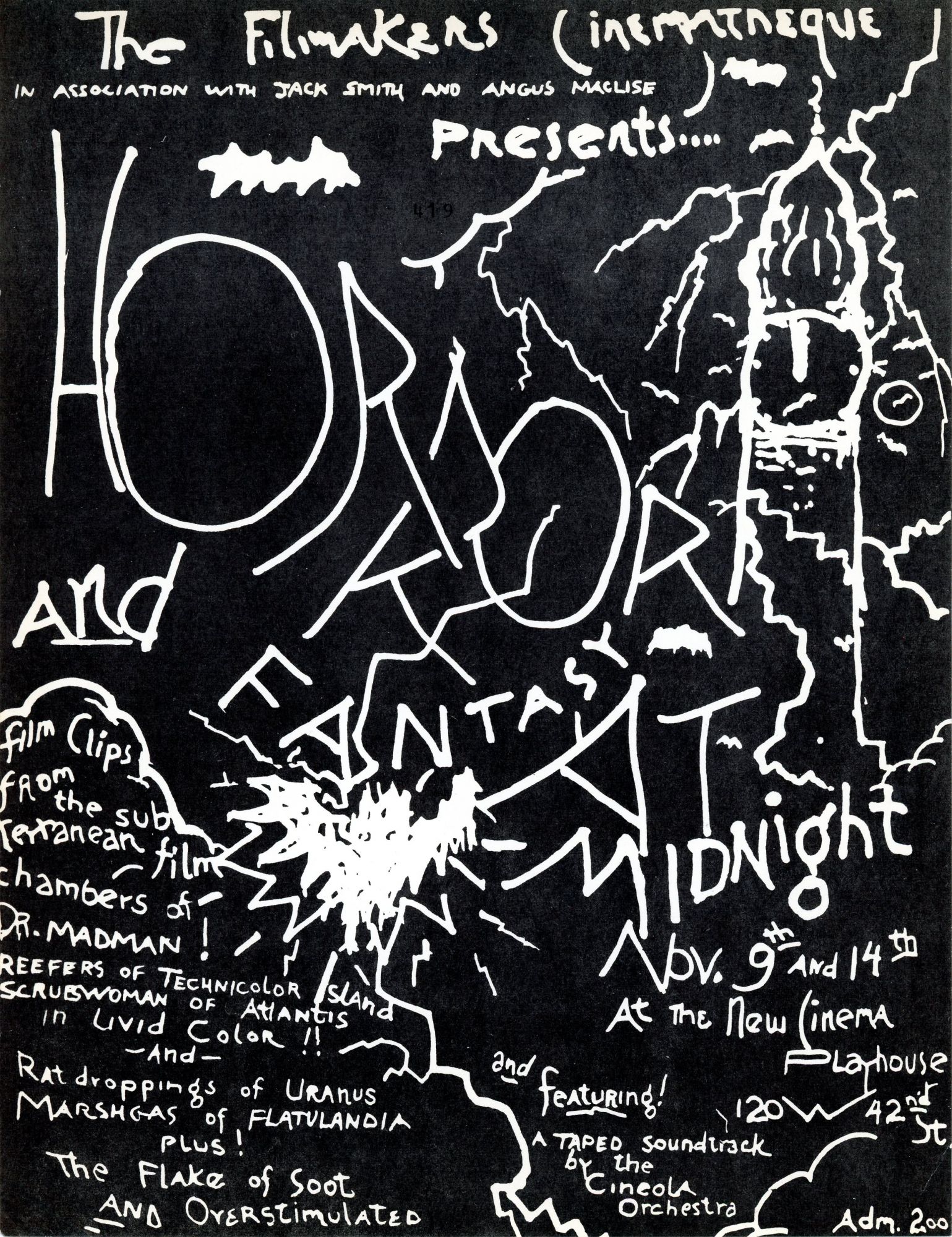
Poster

Alternate cover for Irving Rosenthal’s ‘Sheeper’
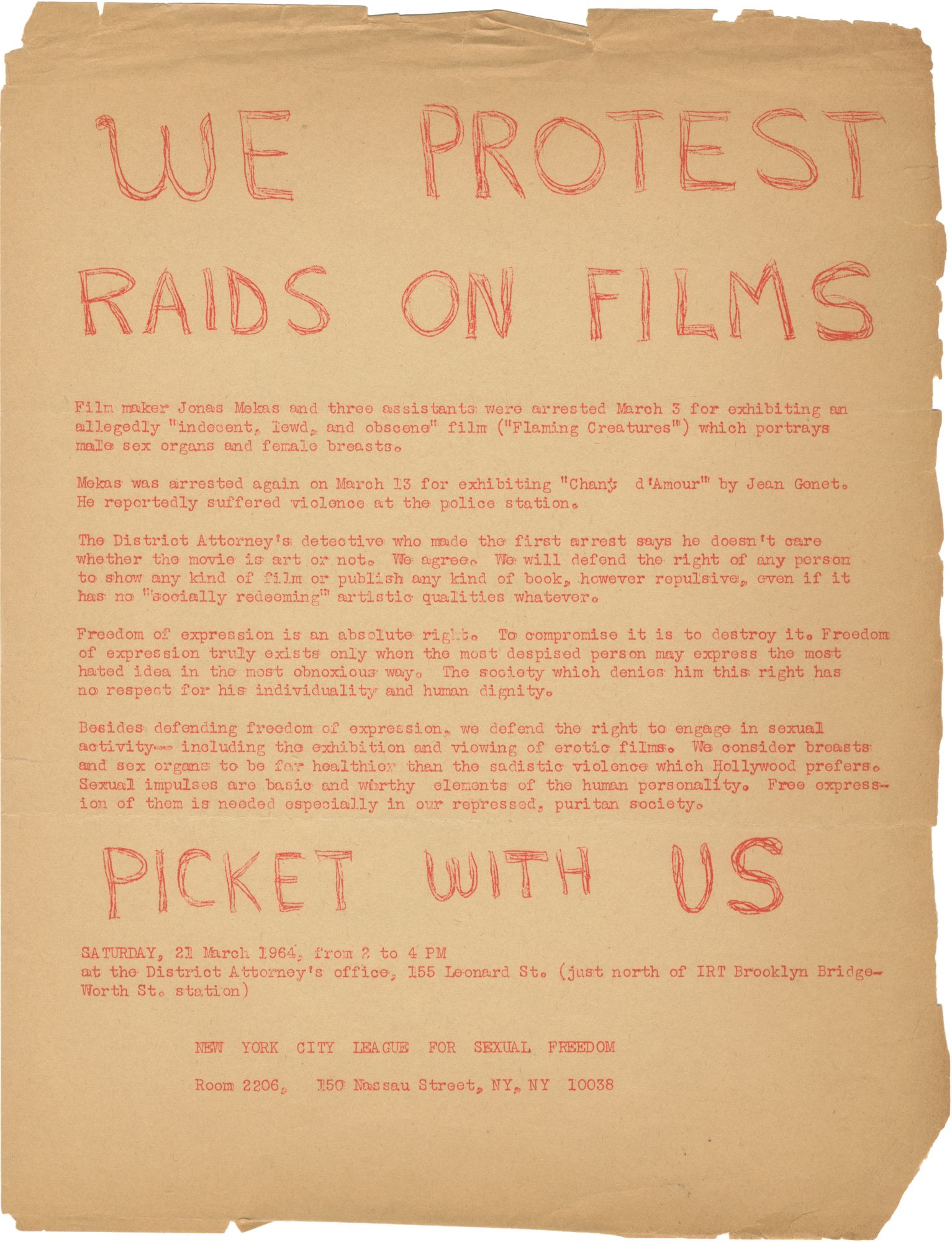
Announcement in protest of police repression and censorship of Jack Smith’s ‘Flaming Creatures’.
_______________
J.S. (Je Suis/Jack Smith)
by Felix Bernstein

JAY SANDERS: When did you meet Jack?
FELIX BERNSTEIN: Well, I was really young, and Jack, at the end, nobody really liked him, I would just hang out on the lower east side, I was a poser, I wasn’t an artist, I wasn’t really interested in culture, I just found the lower east side a compelling place to experience things.
I would pick up guys, I would cruise, basically one of the guys was Jack, and he had all these punk neo-Nazis hanging around with him. Ludlum was over, and the Club Kids were a mess, and Jack was really generous, and I wouldn’t be an artist or anything if it weren’t for his generosity. He would tell me to meet him for a rendezvous or whatever, but he wouldn’t even show up. But that taught me a lot. Him not giving me attention made me show up in wilder and wilder costumes. I was called a child prostitute, but I wouldn’t think of myself as that, but as a rebel. We had a lot of encounters where we wouldn’t talk. He would give just little statements, not positive or negative, that just pushed me along. I think of that as generous. Pina Bausch, or someone like that, is very hands on, obviously…. Jack wasn’t even there. It was a teaching in absence.
Was it difficult?
Yeah cause you’re put on the spot and there’s no one there for you. His father died when he was very young, in a sea accident.
I don’t want to say I came into my own because he didn’t want me to come into my own. I wasn’t self-possessed; I didn’t have a self, and he took that material and used it.
Anyone who evaluated him was ascribed as a monster, patriarchal, crazy. I grew up in a world where there was no evaluation. You can imagine that having a teacher like that wasn’t an easy situation. He wasn’t evaluated and didn’t evaluate me, but I learned from him to evaluate others. But nowadays, German art magazines pay me to say the sort of stuff Jack Smith said. They love to see me bite the hand that feeds.
What about ideas? Did he have any ideas?
His ideas were already out there, and people used them all the time. When I was on St. Marks Place I was bored, cause everyone wanted to be Jack, and I didn’t. I didn’t want anything to do with him, and I think that’s why he found me.
I had no diva worship for Jack, and I don’t like Jack and I don’t like who you think he is. To put it cutely, You Don’t Know Jack, and that was the space of our interaction. I’m not gonna dress up as a Flaming Creature and dance around Barbara Gladstone gallery or at a Pride parade. He would hate that. In fact, I’ll let you know: he hates you, if you do that. And if you say performance art is subversive in a museum, he’ll kill you.
Did you ever have sex?
The phallus is an organ belonging to the father, and Jack’s father was dead but he didn’t care. Jack had no phallus: he hated phallic men. He just had a flaccid penis, hanging around all the time. That’s what’s so “obscene” about his film Flaming Creatures; there are no erections.
Jack was at that weird time: the birth of pop art. Like Warhol, he didn’t want to be a subject; he wanted to be an object. But unlike Warhol, he didn’t want to be a commodity, even though he loved the world of commodities—Maria Montez and the starlets. But Smith liked being the pivot between subject and object. He couldn’t settle on one or the other, and it drove him. Most of us pick. He wouldn’t. He was neither Batman, the hero, the free agent or Dracula, the bloodsucking villain (he played both in his one filmic collaboration with Warhol)—it’s clear that Warhol chose to be a vampire, an undead object who fed off of the lives of subjects.
What did he invent?
Everyone in Greek Theatre knows what this look means. He didn’t splinter the disclosure of thinking but some people think he did. But he wasn’t expressive. It wasn’t about the outpouring of emotion. The beauty of Smith’s Hamlet is that emotion is rendered through objective correlatives, and it connects you to the subject through a skewed view. You directly feel it through indirection, as T.S. Eliot has explained of Shakespeare’s Hamlet.
Nowadays all intimacy is delayed through parody and irony…but for Smith there was no deferral. The indirect was always already directed at the viewer. It was an instantaneous transferal through spontaneous yet effective bodily hieroglyphics.
Famed experimental artist Tony Conrad was originally Smith’s intern. Of course, Conrad is a straight, minimal artist. Conrad was using drugs to control his emotions: to go from happy to sad, the two faces of theatre—all very simple, controlled, framed. Jack Smith, Conrad thought, was so corny and emotional. And this helped him reduce emotions to stark symbols. Maximalism became minimalism. In turn, it is true that Smith invented minimalism. And he turned away from Kant’s subjectivism towards a new paradigm: the subject-as-object or the subject as thing.
For someone like Jack Smith, what’s the boundary of an artwork?
To be or not to be, to be art or not to be art, hard or soft dick, wavering, stuck in wavering, because phallic authority is dead. That lack of resolution became what others manufactured in their attempts to claim his legacy. Even Warhol.
Jack Smith didn’t hate all proper names. He always hated the one, who led the chain gang of signification: Jonas Mekas, that was the master signifier he abhorred. Smith was always playing the crazy polymorphous signified. That was Jack Smith, or Jack Smith was that thing. Mekas uses his subjectivity to interpellate and determine, Smith was always the interpellated thing. Young performance artists and queer academics always say with a smile, “that was Jack Smith.” But perhaps the “that” that was Jack is really just the stab in the back caused by the reclusive and elusive referent. So it is not wrong when everyone says “that was Jack Smith,” the one who sent me that strange and hostile letter. That was him since he was always that thing, and we were always determining him through such anecdotes.
We’ve talked about the reptilian technique. How did Jack Smith convey his own technique?
Interns became baroque apprentices. You can never master baroque art but you can at least be told about it. The student can never be more than a subjective creature; only he was ever really an object; and so he remained better than us. We would decorate or be “flaming,” he would watch us then morph based on what he saw us seeing. Like Warhol, he was a voyeur not a “flaming” participant, like the modern gay/queer artist. But unlike Warhol, he would become what he watched the watcher watching. Thus, Warhol’s cruel glare was more than just a subjective standpoint for Smith—but rather, it was also an internalized compass for designing selfhood.
What do you think about his legacy?
John Waters said about Jack Smith: that he bit the hand that fed him. He’s wrong. Jack Smith was never even fed. Rather, he fed the hand that bit him. Not to over-emphasize the point, but Jack Smith’s dad died at sea. He was untreatable and unfeedable, because you cannot treat someone who does not accept, as an ontological premise, the supplement of health—he was the living embodiment of what Richard Foreman termed the Ontological Hysterical Theater.
Can Smith be anything more than a dodo? What does Jack Smith mean for productivity?
Plenty of people will say, Jack Smith is a real artist, but Rent the musical is superficial. They are wrong. Gay Marriage is neoliberal fantasy and so is Rent but your critique is just as neoliberal. Protesting gentrification is gentrification. Jack wouldn’t have cared about Rent: it would’ve been as good as anything else. Idina Menzel might even be our Maria Montez.
Funny story—a budding hip gay artist blocked me from all his social media accounts after I wrote a critique of his safe aesthetics—an hour later, he shared a glossy ArtForum essay that praised Jack Smith for being an aggressive trailblazer. “Never conform,” he tweeted as a caption. Jack Smith is rolling in his grave. Or anyway, Jack Smith is the thing that rolls in a grave.
_______________
Jack Smith’s 12 films
_______________
Buzzards Over Baghdad (1952)
‘Jack Smith was born on November 14, 1932 in Columbus Ohio to Alvin J. Smith of West Virginia and Chrystine Mayo of Hazelton, Pennsylvania. When he was seven his father died in a fish boating accident off the Gulf Coast after his family had moved to Texas. Jack, his sister and mother lived in trailer parks until his mother remarried in approximately 1945 and the family moved to Wisconsin. When he graduated from high school in Kenosha, his parents gave him his first movie camera (8mm), which was stolen from him shortly thereafter. He left home and moved to Chicago in 1951 and then to Los Angeles in 1952 where he begun making a 16mm film later titled Buzzards Over Baghdad.‘ — warholstars.org
Buzzards Over Bagdad by Jack Smith, an underground movie flip book
_______________
Scotch Tape (1963)
‘With Jerry Sims, Ken Jacobs and Reese Haire. 16mm Kodachrome shot on the rubble strewn site of the future Lincoln Center. The title arises from the piece of scotch tape which had become wedged in the camera gate.’ — Light Cone
the entirety
________________
Overstimulated (1963)
‘This short film, restored in 1995, stars Jerry Sims and the late filmmaker, Bob Fleischner. It is an early filmic exploration of the ‘aesthetic of delirium’ which Smith developed in his later films. At one time, in the 1970s this film was treated by Smith as a fragment, and included in various film/performances with No President.’ — J. T. Plaster Foundation
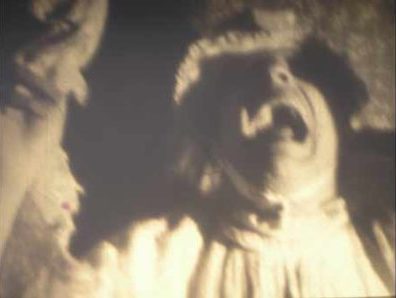
_______________
Flaming Creatures (1963)
‘Jack Smith has graced the anarchic liberation of new American cinema with graphic and rhythmic power worthy of the best of formal cinema. He has attained for the first time in motion pictures a high level of art which is absolutely lacking in decorum; and a treatment of sex which makes us aware of the restraint of all previous filmmakers. “He has shown more clearly than anyone before how the poet’s license includes all things, not only of spirit, but also of flesh; not only of dreams and of symbol, but also of solid reality. In no other art but the movies could this have so fully been done; and their capacity was realized by Smith.’ — Film Culture
Trailer
the entirety
__________________
Yellow Sequence (1963)
‘This is a gold-toned coda to “Normal Love”. Featuring Tiny Tim and David Sachs.’ — The Film-makers Coop
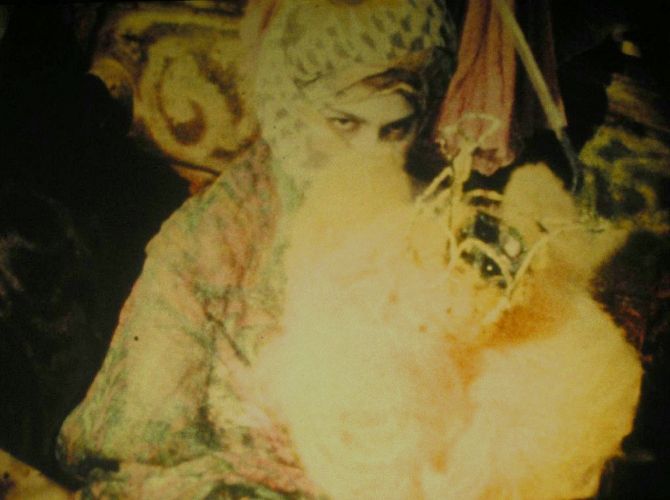
_______________
Normal Love (1963)
‘Normal Love is a 16mm color film by Jack Smith, shot in 1963, and shown in 1964. But Normal Love was not always Normal Love; the work was also called Normal Sex, The Great Moldy Triumph, The Great Pasty Triumph, The Pink and Green Film, The Pink and Green Horrors, The Rose and Green Horror, The Moonpool Film, and The Drug Film. And, in its initial incarnation, it was a short story about freaks, sex, and God. In its ineluctable multiplicity, Normal Love must be examined as emblematic of Smith’s legacy as a whole: it exists in many versions, is unfixed, and difficult to fully account for in textual form.
‘To consider the film Normal Love, then, one must first consider the personality, the ideals, and the life of Jack Smith. He was a perpetual revisionist; his art was always evolving and his work was all-consuming—of effort, of others, and of time that insisted on the priority of the present moment. Throughout his life as an artist, Smith worked in various modes: composing vibrant and exquisite photographic images that resemble film stills for nonexistent films; presenting performances in his New York loft apartment that ran for unspecified lengths of time and drew improvised players from the audience in attendance; and continuously reediting his films as they spooled through the projector. The fact that Normal Love is both referred to as an “unfinished” and a “complete” film underscores the paradox of discussing it at all.’ — Isla Leaver-Yap
Excerpt
the entirety
______________
Respectable Creatures (1966)
‘This film, titled by Jack Smith, is an unusual blending of his first known film, “Buzzards Over Baghdad” with stray images from “Normal Love” concluding with material which he shot at Carnaval in Rio circa 1967.’ — The Film-makers Coop

_______________
Jungle Island (1967)
‘Jonas Mekas’s Village Voice review of Jungle Island cited a movie that “starred a most beautiful marijuana plant, a gorgeous blooming white queen with her crown reaching towards the sky.” At some point, Smith combined this with footage of another queen – Mario Montez – seemingly shot on the beach in Florida.’ — J. Hoberman
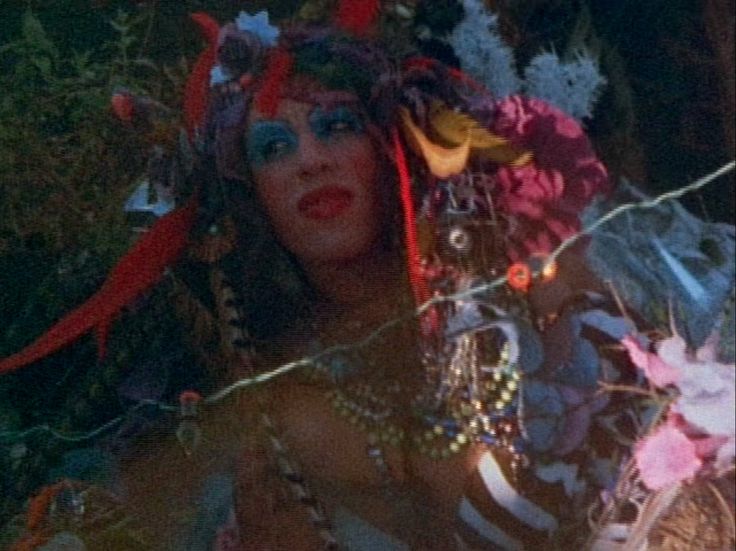
_______________
Song For Rent (1969)
‘Filmmaker Jack Smith stars in this funny short film, playing the cadaverous matron Rose Courtyard (inspired by Rose Kennedy). Dressed completely in red, the wheelchair-bound Rose sits ceremoniously under an American flag, the floor littered with corpses, while Kate Smith sings ‘God Bless America’ on the soundtrack.’ — Light Cone
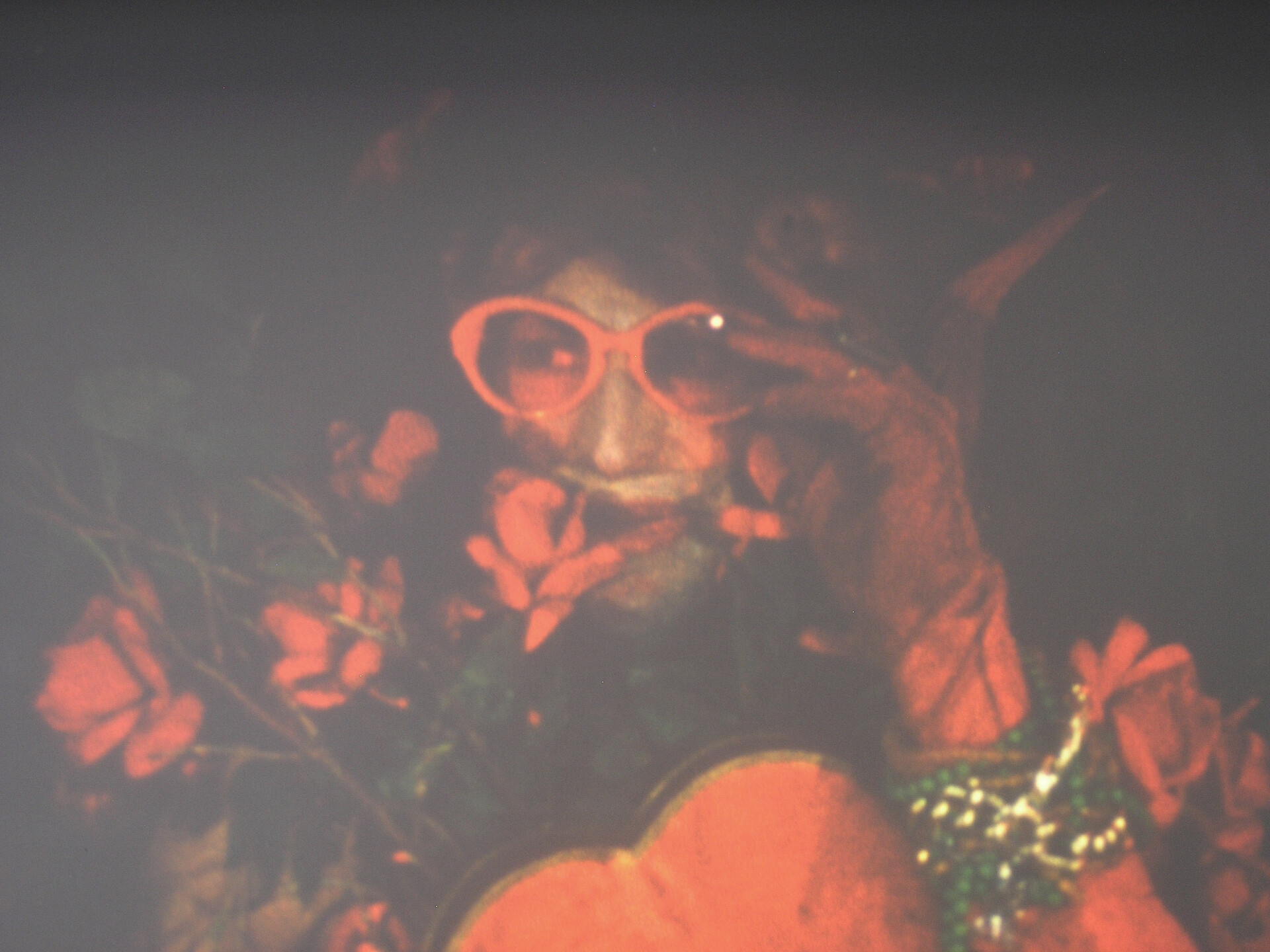
Malic Amalya Song for Rent, After Jack Smith (2019)
_______________
No President (1967)
‘Smith’s third feature film was originally titled “The Kidnapping of Wendell Willkie by the Love Bandit,” in reaction to the 1968 Presidential Campaign. Willkie was a liberal Republican who ran against FDR in the 1940’s. It mixes B&W footage of Smith’s creatures with old campaign footage of Willkie. The climax of the work appears to be the “auctioning” of the presidential candidate at the convention.’ — The Film-makers Coop
Slide show using still images taken from Jack Smith’s film, ‘No President’
_______________
I Was a Male Yvonne DeCarlo (1967–1970s)
‘Shot mainly during the late ‘60s and edited (or re-edited) a decade or more later, I Was a Male Yvonne de Carlo (as the can in which it was discovered was labeled) is one of several films and slide-shows in which Jack Smith presents himself as a mock celebrity. The movie opens with the excerpt from No President originally called Marsh Gas of Flatulandia – several minutes of black and white footage of steam escaping from manholes segues to an interior scene of various creatures emerging from dry ice vapors – then shifts to color to show the filmmaker, clad in a leopard-skin jumpsuit, attended by a nurse as he sits amidst the detritus of the Plaster Foundation (Smith’s duplex loft cum performing space). Smith waits under the visible movie lights, drumming his fingers. A fan presents him with a black-and-white glamour shot (Smith in profile, posed with a sinuously curved dagger) to autograph as the Warhol superstar Ondine, dressed entirely in black leather, snaps his picture. Violence erupts as the nurse takes out a whip to discipline the star’s fans. When a female creature pulls out the same dagger depicted in the glamour shot, Smith jumps up and shakes the weapon from her hand. The action is post-scripted with footage of a steam shovel patrolling the rubble where a 14th Street movie palace stood.’ — J. Hoberman
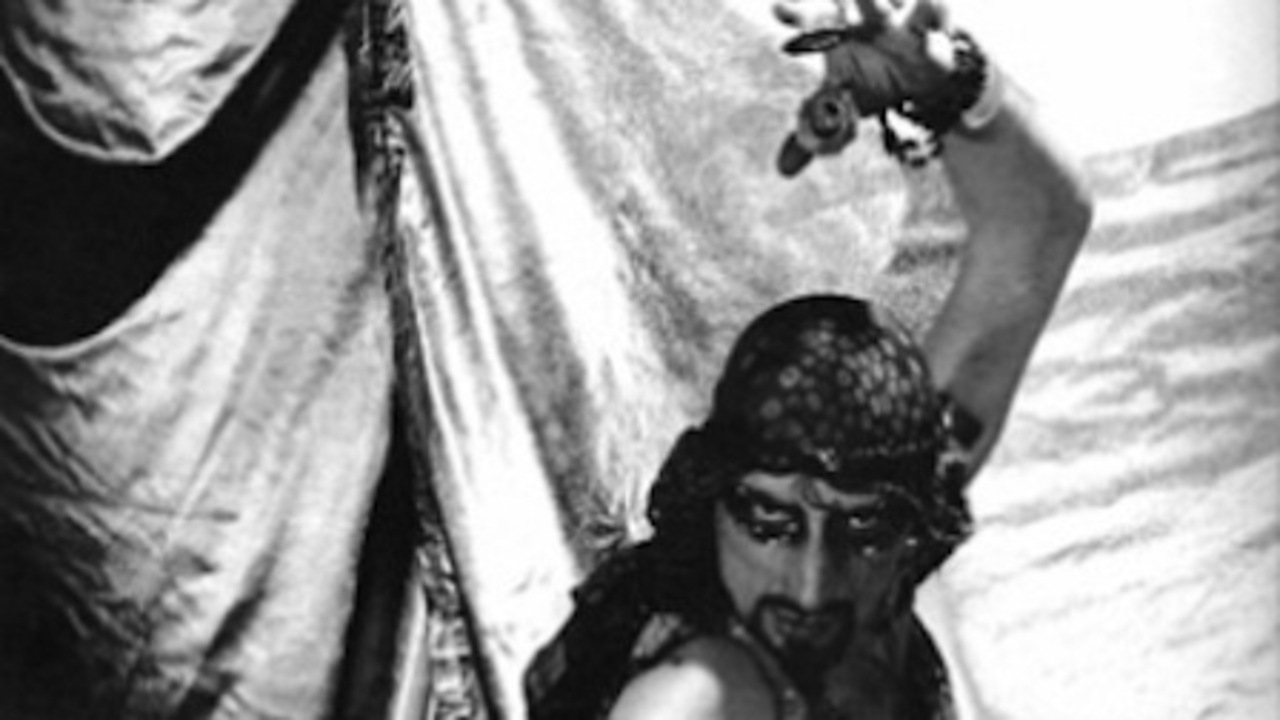
_______________
Hot Air Specialists (1980)
‘A documentation of a Jack Smith drag performance featuring a large red wig.’ — Light Cone

*
p.s. Hey. ** Dominik, Hi!!! Me too. Yes, I thought love that functioned as a social media garbage collector might be useful. Naturally I would gobble up your yesterday’s love’s gift post-haste, thank you, even for the stomach ache. Love storming into the office of whoever cast Timothee Chamalet as Willy Wonka in that upcoming remake and saying, ‘What the fucking hell?!’, G. ** David, Hi. Oh, I can turn into a Google search slut when I command myself to do so. I hope you get your booty today. Very nice piece of appropriate writing there. Do you ever read your stuff aloud like at readings or whatever? I imagine it sounding good. ** _Black_Acrylic, Scotland is so weird, ha ha. ** David Ehrenstein, If I could eat that, I would. ** T, I agree with you on both fronts, but then how could one not? Someone messaged me on Facebook yesterday to tell me they’d eaten strawberry-flavoured cheetos and that they were delicious. Me too, definitely, on the eBook thing, since, like you, I’m way over here and the books I most want are published way over there for the most part. Because I do this blog, sometimes if I beg for a pdf, they’ll send me one. There is a great Paris bookstore, After8, that carries a small number of the books I want and will order things, but then you run into the same problem. I still haven’t read ‘2666’. It’s been a must-read for an awfully long time, and I really need to start. Well, I could definitely use that Wednesday you wished for me, couldn’t I? How’s stuff with your landlady? I wish you a Wednesday wherein your landlady brings you a plate of the most delicious scones ever made that additionally have the power of giving their eaters eternal life. ** Corey Heiferman, Poor soul, or, wait, lucky you. I forgot you were in NYC for a moment there. Mm, it sounds like that event was very mildly doable. Oh, well, better than nothing. Sabrina, Zac, and I (but mostly Zac and I) designed and wrote the narrative/dialogue for the house/maze (and also appear as 3D modelled characters in it) and designed the layout of the house, etc., and the 3designer guys are building everything and are also having a fair amount of input on the decor since they have lovely ideas. ** Steve Erickson, I haven’t listened to ‘Cut the Crap’ in a billion years, but I sure do remember it being awful. If it gets an A for misshapen intentions, that sounds plausible. Yeah, US health insurance … I don’t have health insurance, which is stupid, but it’s such a mess over there. Maybe this year will see a huge upswing in edible-infused Halloween candy now that it’s fairly affordable. We’ll see. ** Cal, Hi, Cal. Yes, that’s still my email. Let’s sort it. You can send me the actual text in question, sure, although I warn you that I’m swamped getting the virtual Haunt project finished, and I may only be able to give it a quick read, but still. ** Florian AF, Howdy, Florian. I hope you release that album, naturally. Let me know if you do, or mention it on FB. I don’t know the dates of ‘Crowd’ at BAM, but I’ll ask Gisele the next time I talk to her, and I’ll let you know. Increasingly happy Halloween build up to you! ** Okay. I can’t believe I haven’t done a Jack Smith post before now, but it’s true. See you tomorrow.




 Now available in North America
Now available in North America 
Thanks Dennis… yes the magazine cover just arrived!!! the head is too big to cut around and use on the old sex guide book I’m in… I posted a pic on your facebook (today’s post) to show the idea… think digitally doing it maybe better. as the picture I posted shows… glad I’ve got the cover though… may frame it at some point… you get the idea right? he’s like the ultimate protector etc… (that role is often reversed in my head as well…) it is also considerable contempt for this and that…. although the photographer of the book ‘Robert’ was a very sweet and lovely guy….
Glad you appreciated the poem… there were various titles… tying in with JG Ballard’s the Atrocity exhibition… but didn’t want to be too mean… I have read my stuff only in my room.. various rooms… I have used the recorded free online robotic voices slowed down etc… I’ve not read them to other people apart from friends/family… I always imagine other people reading them and not myself to be honest…. thanks for this post!! and for the sweet comments xx
Jack Smith is endlessly fascinating. It would be great if someone did a major warts-all biography on him and his work. I met him once as a child when he came to visit my dad in Beverly Glen sometime in the early 1960s. Wallace took a really nice portrait of him in our backyard. You and Zac’s haunted house project sounds wonderful. A dream project!
Jack Smith is endlessly fascinating. Someone or publisher should do a huge biogaphy on him and his work. I met Jack Smith as a child sometime in the early 1960s. He came to our home in Beverly Glen to see my dad. Wallace took a really great portrait of Jack in our backyard. And congrats on your house/maze project. A dream work!
The firstchaper of my book Film: The Front Line:1984 is devoted to Jack. Charles Ldlam once said “Jack is the Daddy of us all!” And he was — working (or more to the point wretling) with the likes of Andy Warholand Robert Wilson. Andy appears in “Normal Love” in drag *shredded thrift storedressesth that Jack found) He made a memorable appearance in Wilson’s “Deafman Glance” –screaming at all and sundry at the top of his lungs..
One of the best books about Jack is Stefan Brecht’s “Queer Theater.” Jack was a multi-tasker. He made films, staged played, drew pictures and took photographs.
It’s a shame his apartment wasn’t made into a Natonal Memoria. H shot many of his films there, turning his bathroom into a set for Mario Montez to ape Maria.
When he died of AIDS Jackhad an incongruously pleasant tilme because he adore hospital food.
There willnever be another like him.
Oh and when I last looked Irving Rosenthal is still with us.
Dave Chappelleshould be Terminated with Extreme Prejudcie
Netflix Has Declared War on Trans!
Hi!!
Your poor love, haha. I’ve got nothing against Timothée Chalamet, but I sure as hell can’t see him as Willy Wonka… I guess literally everyone wants him in everything since “Call Me by Your Name”? Love turning into a Dorian Electra lookalike at every full moon, Od.
I also can’t believe this is your first Jack Smith post. That interview with Felix Bernstein is hilarious.
I know I promised you a Joel Lane post; it’s coming (slowly). To make things more complicated, one of his long out-of-print collections, which I’ve never been able to find, just got reissued. If my order takes awhile, I’ll just wrap up the post without it.
Bill
Hey Dennis. I read about Jack Smith’s stuff in the book ‘Cruising Utopia’ by Jose Munoz when I was 17. The book had quite a major impact on me, at that time anyway, but for whatever reason I didn’t like, actually search out its references, which seems crazy to me now. So it was pretty weird but good to watch ‘Flaming Creatures’ today and have it edit my very straightforward past remembered fantasy to something a lot more ambiguous and enigmatic and kind of unsettling…. The Felix Bernstein interview seemed to get more to the centre of my feelings on it. Will try to spend some more time after today going through his filmography.
Thanks for the bookstore rec! I might even check it out if I get some time when I’m Paris-bound towards the weekend. And yeah, for the moment, I would recommend 2666! I generally get frustrated with massive books that they could put all their ideas in half the page count, but for the moment it seems to be bucking that trend. That said, I’m only on page 300 or so out of 900 odd, so I might be jinxing it haha.
And finally, with regards to my landlady, apart from her manifold complexes about various things such as how I air my room, open/shut the doors in the house, use the kitchen and bathroom (ie generally running her house like a mini totalitarian state), things are ok-ish! Dunno how much I’ve said to you before, but essentially she’s charging me 200 euros a month for rent and full board so for the moment I’m sucking it up and getting away at weekends and on my day off. It is bearable enough though, I shouldn’t vent. And she made us actual (rather than semi) vegetarian food today, which if I’m honest might as well be the fucking elixir of life as you wished me! Wishing you a Thursday that trusts you to leave doors open or shut or at any which degree from 0 to 180 which you feel is appropriate, xT
Latest FaBlog: Separated at Birth?
Pretty sure I watched a Jack Smith doc. Or thought of watching one. I have a book of his writings. Do you like Ira Cohen, some of the pics look like his. I like Ira Cohen a lot. Need to watch Flaming Creatures. Currently reading Negrophobia, it’s great!
I wrote my dissertation on Jack Smith! and Gore Vidal – Maria and Mario Montez. Hope you’re doing well x
A HREF=”https://www.youtube.com/watch?v=ydhyoYHvXXg”> GEEF ME DE COPARAH JOOL!